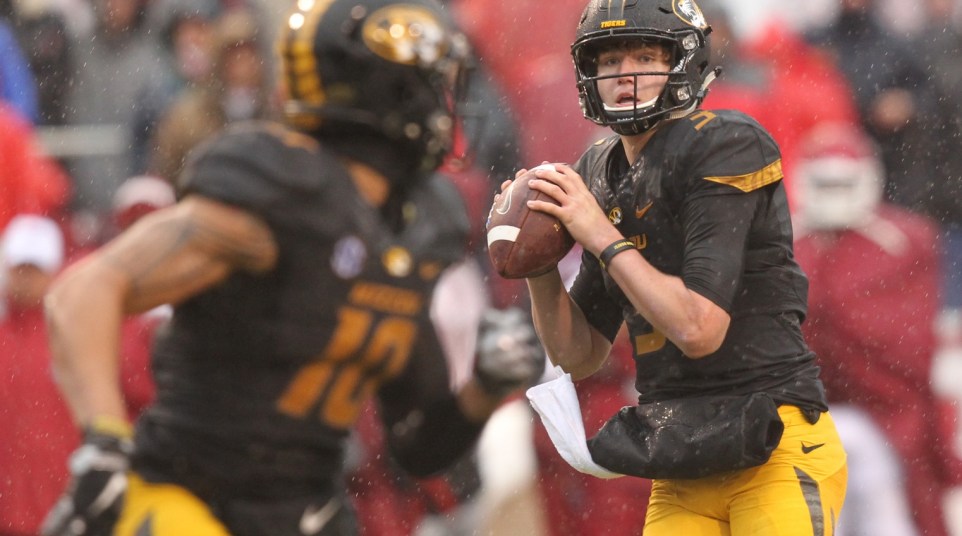
Biggest recruiting hotbeds: Missouri
EDITOR’S NOTE: In an 11-part series, Saturday Down South contributor Gary Laney looks at the states in the SEC and what areas in those states produce the most players, per capita. The method was to count players who have earned at least a four-star rating from 247Sports’ composite rankings, because that ranking takes into account the rankings of all the recruiting services. We then calculate how many of these blue chip recruits each metro area has produced per capita over a five-year period from 2012-16. At the end, we’ll rank the 10 biggest hotbeds in SEC country in per capita player production.
When Missouri won the first of two straight SEC East titles in 2013, the Tigers had 34 players from Texas on the roster, including star quarterback James Franklin, mighty mite running back Russell Hansbrough and co-SEC Defensive Player of the Year Michael Sam.
That was a leftover from the Big 12 era when, playing in a league dominated by Texas schools, the Tigers were able to dive in for Texans with the promise of “homecoming” games against the four Texas schools.
Fast forward to 2015 and a 5-7 Missouri team — the last for head coach Gary Pinkel — had just 19 Texas players. In Year 4 in the SEC and with only one Texas rival (and Texas A&M is in the other division of the SEC, meaning Mizzou will rarely travel to College Station), is the Lone Star Pipeline drying up? And does Missouri need a new breadbasket of players?
Because one thing is for sure: There are slim pickings in the home state.
In the five-year window from 2012-16, Missouri produced just 16 prospects rated four-star or better by 247Sports’ composite rankings. Only one of them, receiver Dorial Green-Beckham, was rated a five-star prospect.
There are exporter states in the SEC footprint (Georgia, Texas, Florida) that are so talent-rich their programs can shrug off losing highly regarded prospects to out-of-state schools. There are states where the local power can win big based primarily on local recruiting (Alabama, Louisiana), then there are the importer states, like Arkansas, Kentucky and Missouri, where they can’t win without leaning on out-of-state help.
With two SEC East titles in four years in the conference, Missouri is certainly importing well. But it would also do well if it had more local heroes to pick from. Here’s what the state has been producing:
Note: sorted by per capita production:
| METRO AREA | SIZE | PER CAPITA | 5 STARS | 4 STARS |
|---|---|---|---|---|
| Jefferson City | 150,000 | 1/150,000 | 0 | 1 |
| Columbia | 173,000 | 1/173,000 | 0 | 1 |
| Kansas City | 1,225,000* | 1/244,600 | 0 | 5 |
| St. Louis | 2,202,500* | 1/275,312 | 8 | 0 |
| Springfield | 534,000 | 1/534,000 | 1 | 0 |
| Joplin | 207,000 | 0 | 0 | 0 |
| St. Joseph | 127,300 | 0 | 0 | 0 |
| Cape Girardeau | 96,000 | 0 | 0 | 0 |
* – Reflects only the Missouri side of the Metro. Much of the Kansas City metro area is in Kansas, and much of St. Louis’ metro area is in Illinois.
Three things to know
- Just a slump?: In 2012, Missouri produced seven prospects rated four-star or higher, led by Green-Beckham. Since then, it’s been a steady decline. The 2016 class produced just one four-star prospect in Wisconsin signee A.J. Taylor. The 2017 class is similar with the only four-star prospect being defensive end Chester Graves.
- They aren’t particularly loyal: Of the 16 top prospects, only six opted to stay with the home-state Tigers. The other 10 chose a variety of schools from Wisconsin to Alabama to Oregon to Florida State, a group that includes all the Power 5 conferences.
- It’s a city thing: Where states like Georgia and Mississippi produce a lot of top talent from tiny towns you’ve never heard of, in Missouri, most of the talent appears to come from the large metro areas. Greater St. Louis leads the way with eight four-star players, followed by Kansas City with five. All 16 top prospects are from towns within defined metro areas.
Program to know
No program has produced more than Lee’s Summit West in the southeastern suburbs of Kansas City. Among the prospects from there in the last five years was center Evan Boehm, a four-year starter. The program produced four players who were among the top five prospects in the state in the 2012-16 stretch. When you throw in current Mizzou starting quarterback Drew Lock from Lee’s Summit Sr. High, the state’s top prospect in 2015, the suburb of 95,000 people has been the epicenter of player production in the state.
